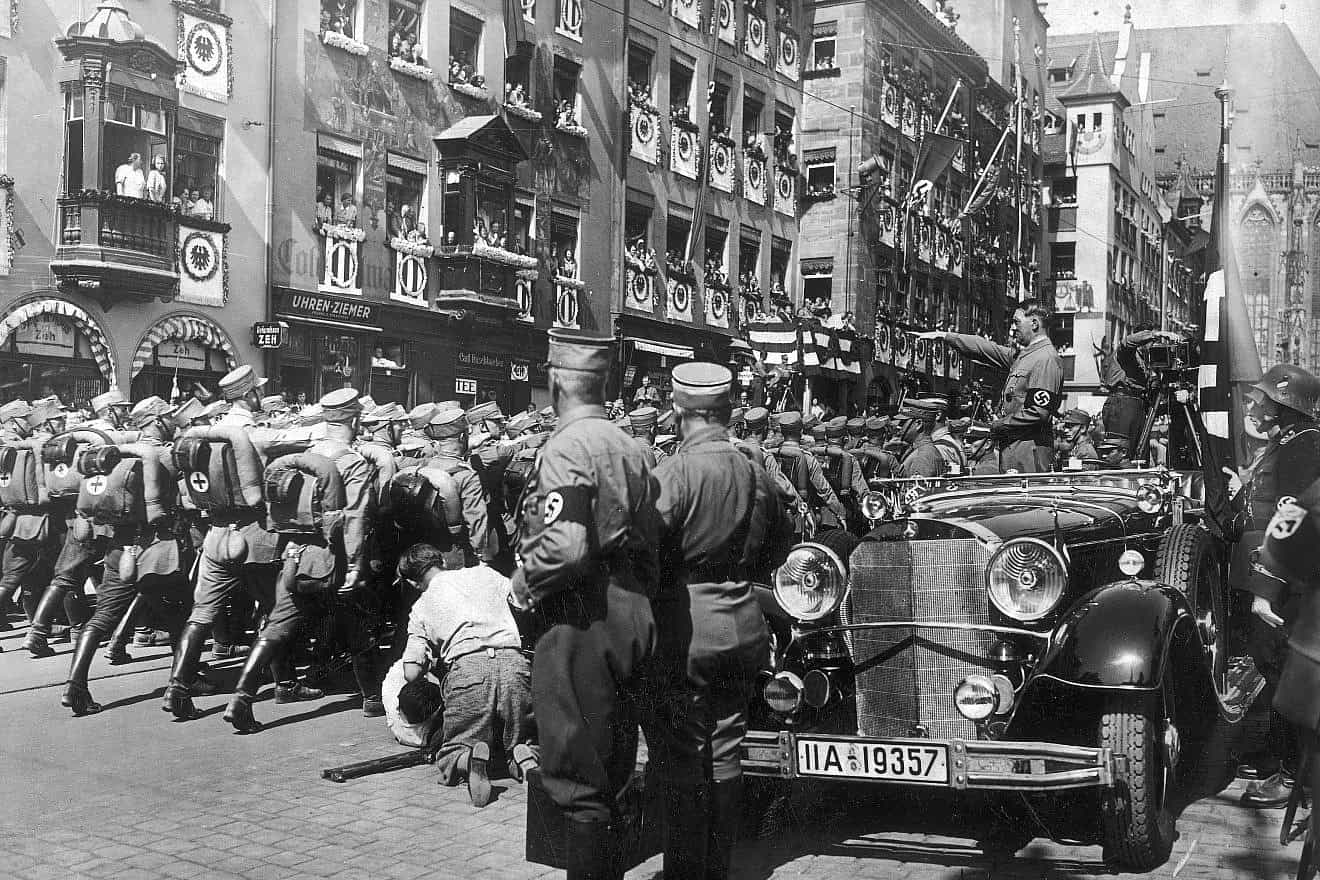As we sit comfortably in our American homes, enjoying the freedoms and opportunities afforded to us by this great nation, it is difficult to imagine that we, as Jews, could be facing a situation reminiscent of the dire circumstances encountered by our ancestors in Eastern Europe during the 1930s. Yet the continued unsettling rise in antisemitism across the globe and here in the United States compels us to ask: Are we the Jews of the 1930s? While it is true that we are not experiencing the horrors that led to the Holocaust, the alarming parallels between the past and present warrant our undivided attention and action. Oct. 7 should have been a new line in the sand for all 16 million Jews worldwide. The awful turn of events castigating the Jews as the bad guy in this fight should have set off alarms for all of us.
In the 1930s, Jews in Eastern Europe faced escalating hostility, institutionalized discrimination and violent pogroms. They were scapegoated for economic woes and societal ills, leading to widespread persecution and eventual genocide. Today, we see a disturbing resurgence of antisemitism, characterized by hate crimes, vandalism of synagogues and Jewish institutions, and virulent rhetoric both online and in public discourse. While our circumstances are not yet as severe as those of our ancestors, the signs of rising antisemitism are unmistakable. The activities taking place on college campuses alone should cause us all considerable alarm.
According to the Anti-Defamation League, antisemitic incidents in the United States have been increasing at an alarming rate. In 2023, the ADL reported a record 8,873 antisemitic incidents, including assault, harassment and vandalism—a 140% increase from the previous year. These incidents are not isolated to fringe elements but are permeating mainstream society, with public figures and celebrities sometimes perpetuating harmful stereotypes and conspiracy theories.
In the 1930s, Jews in Eastern Europe were similarly subjected to a growing wave of antisemitism that was normalized and eventually institutionalized by Nazi ideology. The public’s tacit acceptance and, in many cases, active participation in the scapegoating of Jews laid the groundwork for the atrocities that followed. Today, we must be vigilant in recognizing that the normalization of antisemitism in any form is a dangerous precursor to more severe persecution.
The economic turmoil of the Great Depression in the 1930s provided fertile ground for antisemitic scapegoating. Jews were blamed for economic hardships, financial crises and societal decline, leading to increased marginalization and violence. In contemporary America, we see echoes of this dangerous rhetoric. Jews are often blamed for various societal issues—from economic inequality to political corruption, despite their significant contributions to society.
Conspiracy theories, such as those propagated by the QAnon movement, often target Jews, portraying them as part of a shadowy cabal controlling global events. These baseless accusations fuel hatred and division much like the anti-Jewish propaganda of the 1930s. The persistence of such narratives indicates a troubling continuity in the use of Jews as scapegoats for broader societal anxieties. When factored in with the hatred stemming from the far left, Jews have a difficult time staying out of both the literal and figurative crosshairs.
In the 1930s, Jews faced institutional discrimination that restricted their access to education, employment and political participation. This systemic marginalization reinforced their outsider status and made them vulnerable to further persecution. While Jews in America today enjoy legal protections and opportunities, there are instances where institutional bias still exists. Discrimination in hiring practices, educational opportunities and social acceptance can subtly perpetuate a sense of exclusion.
Furthermore, the resurgence of nationalist and populist movements often brings with it a dangerous undercurrent of antisemitism. Politicians and public figures who traffic in xenophobia and bigotry contribute to an environment where antisemitic attitudes can flourish. It is essential that we recognize and challenge these trends to prevent the kind of institutional discrimination that characterized the 1930s.
One of the most pernicious aspects of the antisemitism of the 1930s was the cultural and social isolation imposed on Jews. They were segregated from broader society, barred from certain professions, and excluded from social and cultural life. This isolation made it easier for dehumanizing myths to take root and for violence to be justified.
In contemporary America, Jews are not subjected to the same overt segregation, but there are subtler forms of social exclusion and cultural isolation. Antisemitic tropes and stereotypes in media and popular culture can perpetuate harmful images of Jews as outsiders or “others.” Such cultural marginalization can contribute to a sense of vulnerability and alienation among Jewish communities. This type of bigotry and hatred is not tolerated against other ethnic groups.
What is transpiring across the Diaspora on college campuses, by college administrators and professors, and in virtually every other segment of society should both frighten and anger every living Jew. We were seeing random acts of violence that have now turned to an everyday occurrence against Jews of all types. If you dare to show that you are a Jew, be prepared to be physically assaulted while bystanders watch and do nothing.
Part of a larger struggle against all forms of bigotry
One of the tragic lessons of the 1930s is that many Jews did not fully recognize the danger they were in until it was too late. Complacency and a desire to believe in the fundamental goodness of their neighbors led many to ignore the warning signs of escalating antisemitism. Today, we must not make the same mistake. While we are not facing the same level of immediate threat, the increasing frequency and intensity of antisemitic incidents should serve as a wake-up call.
It is essential that we remain vigilant and proactive in addressing antisemitism in all its forms.
This means supporting organizations that fight hatred; educating ourselves and others about the history and consequences of antisemitism; and standing in solidarity with other marginalized communities facing discrimination. We must also hold our political leaders accountable, demanding that they condemn antisemitism unequivocally, and take tangible and actionable concrete steps to protect Jewish communities.
In our post-Oct. 7 world and with Israel continuously castigated as both the bad guy and the oppressor, we must be diligent in how we approach everything: the media’s dangerous portrayal of events, the anti-Israel venom masked as “Israel needs a new leader,” and the partnership by and between those against us who are at best strange bedfellows. When everyone has a hatred of Jews, it’s easy to make that a rallying cry and join forces.
In response to the rising tide of antisemitism, we must take steps to empower ourselves and our communities. This includes promoting self-defense and preparedness, as well as fostering a strong sense of Jewish identity and solidarity. By standing together and refusing to be intimidated, we can ensure that our communities remain resilient in the face of hatred.
We must also work to build alliances with other minority groups and advocate for broader social justice. The fight against antisemitism is part of the larger struggle against all forms of bigotry and discrimination. By supporting each other and working together, we can create a society that is more just, inclusive and resistant to the forces of hate.
As we reflect on the similarities between our current situation and that of Jews in the 1930s, it is clear that we must not ignore the warning signs. While we are not yet facing the same level of threat, the rise in antisemitism in America and around the world is a cause for serious concern. By remaining vigilant, educating ourselves and others, and taking proactive steps to combat hatred, we can prevent history from repeating itself. We owe it to ourselves, our ancestors and future generations to ensure that we are not the Jews of the 1930s, but rather a community that learned from the past and stood up against bigotry and intolerance in all its forms. We said “Never Again,” and now it’s time to make actions speak louder than words.


























